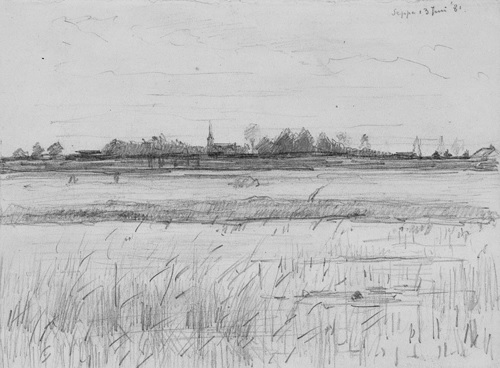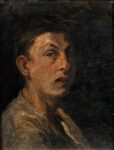
Anton van Rappard
Dutch, 1858-1892
The Passievaart near Seppe, 1881
pencil on paper
4 3/4 x 6 1 /2 in.
Van Gogh Museum, Amsterdam (formerly Centraal Museum, Utrecht)

Anton van Rappard - Self-Portrait, ca. 1878-1883, Centraal Museum, Utrecht
“Rappard, by sticking so close to the academy you’re keeping a spare turn of rope around your arm with which many a man has ‘hanged’ himself – because he couldn’t be free of it when he wanted to choose the sea!” - Letter from Vincent to Anton van Rappard, 23 November 1881
COMMENTS
Most of what is known about Anthon van Rappard comes from the 53 surviving letters written by Vincent van Gogh. Van Rappard was born into a prosperous Dutch family; this afforded him the luxury of pursuing his dream of becoming an artist. With parental encouragement, he attended art schools in Holland and Belgium and in 1879, he studied for six months in the Paris studio of Jean Léon Gérôme. In Paris, he also met Theo van Gogh, who would eventually introduce him to Vincent. Throughout the 1880s, van Rappard became very involved with various Dutch art societies such as Arti et Amicitiae in Amsterdam, the Utrechtsche Kunstkring and the Shelfishclub, both in Utrecht, Pulchri Studio in The Hague and Kunst zij ons Doel in Haarlem. During this decade he also showed his work at various exhibitions in Holland and in 1884 he was awarded a Silver Medal for a painting of a woman spinning at the International and Universal Exhibition in the Crystal Palace in London.
Van Rappard’s most memorable images were his realist subjects; he depicted factory workers, laborers, inhabitants of poor houses and he had a special interest in portraying the blind patients at Utrecht’s Institute for the Blind. In a series of paintings and drawings from 1881 and a second group in 1891, he keenly observed the Institute’s blind knitters, basket weavers and brush makers showing them absorbed in their daily tasks. These carefully observed workers, with their robotic movements are the most moving works of van Rappard’s career; he shows great empathy to their lot in life by characterizing them with dignity and individuality.
Clearly, von Rappard never reached the level of achievement or notoriety of Vincent van Gogh, however the two artists became friends (a rare phenomenon for Van Gogh, who made very few, if any friendships during his lifetime) and confidants, often painting side by side. The relationship between the two artists was explored in great detail in a thematic exhibition at the Vincent van Gogh Museum in Amsterdam in 1974, Anthon van Rappard: Companion and Correspondant of Vincent van Gogh, his Life & all his Works. Between 1880 and 1885, the two artists met regularly in Etten, The Hague, Utrecht and Nuenen. There was always reciprocal support and an interest in each other’s work. Van Gogh would often be critical of van Rappard’s conventional approach to painting, which involved drawing from the nude model and plaster casts, fearing that his friend would lose interest in painting real life imagery. As van Gogh put it, “most certainly one must have a sound knowledge of the nude, but in reality we have to do figures with clothes on” (Jaap W. Brouwer, Jan Laurens Siesling and Jacques Vis, Anthon van Rappard: Companion and Correspondant of Vincent van Gogh, his Life & all his Works, Amsterdam, 1974, p. 34). Also, “Rappard, give up your reservations, and throw yourself headlong into reality” (ibid). And in a later letter Van Gogh wrote: “This much we have in common, that we seek our subjects in the heart of the people.” (op cit, p.36). However, van Rappard could never totally abandon his Academic background, something that had no interest for van Gogh. In 1885, when van Rappard criticized Van Gogh’s The Potato Eaters for its lack of technique, their friendship pretty much came to an end. At the same time, as we look at van Rappard’s work as a whole, it is in his heartfelt Realist subjects where he excelled. It would therefore appear that van Gogh’s words were not ignored and may have even superseded van Rappard’s lifelong defense of technique as an equal to subject matter.
https://www.gallery19c.com/artists/202-anthon-van-rappard/overview/
